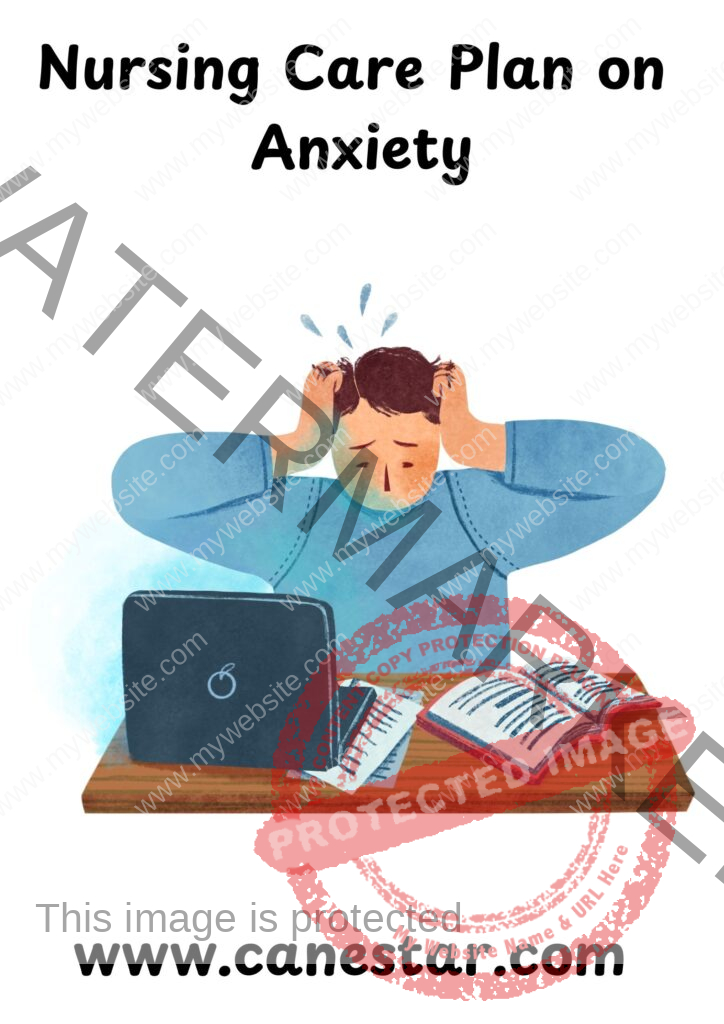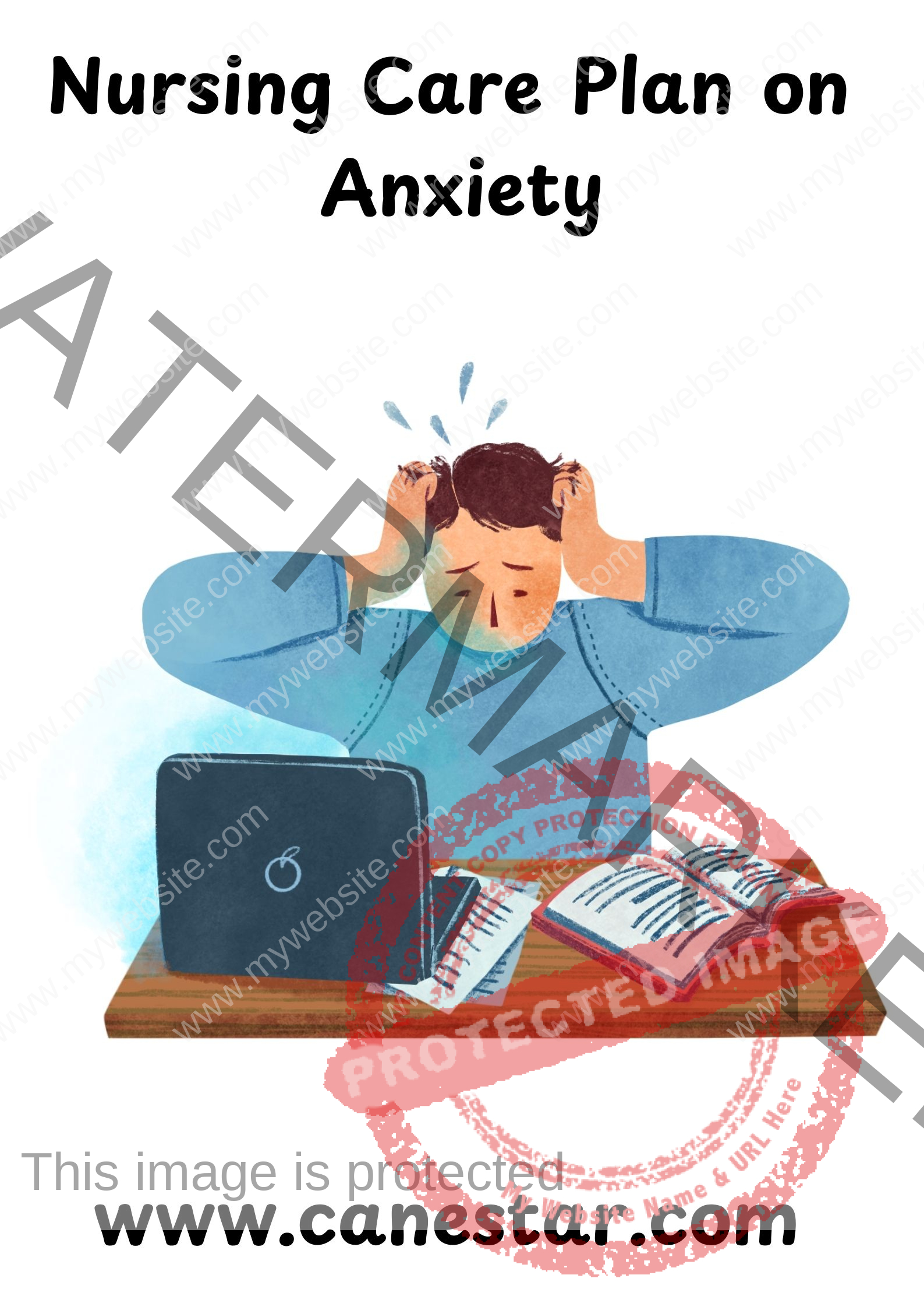NURSING CARE PLAN FOR ANXIETY
NURSING CARE PLAN FOR ANXIETY
NURSING CARE PLAN ON ANXIETY
Anxiety is a psychological and physiological state characterized by feelings of worry, fear, apprehension, and uneasiness. It is a natural response to stress or a perceived threat but can become excessive or chronic in certain conditions, such as generalized anxiety disorder (GAD), panic disorder, or phobias.
Types of Anxiety Disorders:
Generalized Anxiety Disorder (GAD):
- Persistent and excessive worry about various aspects of life such as health, work, social interactions.
Panic Disorder:
- Recurrent, unexpected panic attacks accompanied by intense fear or discomfort, often without a clear trigger.
Social Anxiety Disorder:
- Intense fear of social situations, particularly being judged or embarrassed in front of others.
Phobias:
- Irrational and extreme fear of specific objects, situations, or activities (e.g., fear of heights, flying).
Separation Anxiety Disorder:
- Excessive fear or anxiety about separation from home or loved ones.
Obsessive-Compulsive Disorder (OCD):
- Characterized by persistent, unwanted thoughts (obsessions) and repetitive behaviors (compulsions) to reduce anxiety.
Post-Traumatic Stress Disorder (PTSD):
- Anxiety triggered by a traumatic event, leading to flashbacks, nightmares, and hypervigilance.
Common Symptoms of Anxiety:
Physical Symptoms:
- Increased heart rate or palpitations
- Sweating or trembling
- Shortness of breath or chest tightness
- Dizziness or lightheadedness
- Muscle tension
- Fatigue
- Headaches or stomach aches
Psychological Symptoms:
- Constant worry or fear
- Difficulty concentrating or focusing
- Feeling restless or on edge
- Irritability
- Trouble sleeping or insomnia
Behavioral Symptoms:
- Avoidance of situations or places that trigger anxiety
- Nervous habits like nail-biting or pacing
- Difficulty carrying out daily tasks
Causes of Anxiety:
- Genetics: A family history of anxiety or mental health disorders may increase the risk.
- Brain Chemistry: Imbalances in neurotransmitters like serotonin and dopamine can contribute to anxiety.
- Environmental Stress: Trauma, abuse, financial stress, and major life changes can trigger anxiety.
- Medical Conditions: Conditions like hyperthyroidism or chronic illnesses can contribute to anxiety.
- Substance Use: Alcohol, caffeine, and certain medications can worsen or trigger anxiety.
Diagnosis:
Anxiety is usually diagnosed through a combination of clinical interviews, assessments, and questionnaires. Healthcare providers may use diagnostic criteria from the DSM-5 (Diagnostic and Statistical Manual of Mental Disorders) to determine the type and severity of anxiety.
Nursing Care Plan for Anxiety
Patient Information:
- Name: [Patient’s Name]
- Age: [Age]
- Diagnosis: Anxiety (Generalized Anxiety Disorder, Panic Disorder, etc.)
- Date: [Date]
Nursing Diagnosis:
- Anxiety related to situational crises, health status, or fear of the unknown as evidenced by verbalization of apprehension, restlessness, increased heart rate, and difficulty concentrating.
Assessment Data:
Subjective Data:
- Patient reports feeling nervous and fearful without an identifiable cause.
- States, “I can’t stop worrying about what might happen.”
- Reports trouble sleeping due to constant worrying.
Objective Data:
- Restlessness and pacing observed.
- Elevated heart rate (e.g., 100 bpm) and increased respiratory rate (e.g., 22 breaths/min).
- Tense posture and inability to sit still.
- Difficulty focusing or making decisions.
Goal/Outcome:
Short-term Goal:
- The patient will verbalize a decrease in feelings of anxiety within 24-48 hours.
Long-term Goal:
- The patient will demonstrate effective coping strategies to manage anxiety and perform daily activities without significant distress within 2 weeks.
Nursing Interventions:
Assess the Patient’s Level of Anxiety:
- Use a standardized anxiety scale (e.g., Hamilton Anxiety Rating Scale) to assess the severity of anxiety.
- Observe non-verbal cues (e.g., restlessness, nail-biting, pacing).
Rationale: Assessment helps in identifying the severity of anxiety and guiding appropriate interventions.
Provide a Calm and Reassuring Environment:
- Use a quiet, calm voice when interacting with the patient.
- Reduce environmental stimuli (e.g., dim lights, minimize noise).
Rationale: A calm environment can help reduce the patient’s perception of anxiety and promote relaxation.
Encourage the Patient to Express Feelings:
- Encourage the patient to verbalize their thoughts, fears, and concerns.
- Use active listening techniques and avoid interrupting or judging.
Rationale: Expressing feelings can help alleviate emotional distress and allow the patient to feel supported.
Teach and Promote Relaxation Techniques:
- Teach deep breathing exercises (inhale slowly for 4 seconds, hold for 4 seconds, and exhale for 4 seconds).
- Encourage progressive muscle relaxation (alternately tensing and relaxing muscle groups).
- Introduce guided imagery or meditation.
Rationale: Relaxation techniques reduce the physiological symptoms of anxiety and promote a sense of control.
Provide Information About the Anxiety-Causing Situation:
- Offer clear explanations about treatments, procedures, or upcoming events that may be causing anxiety.
- Allow time for questions and ensure the patient fully understands the information.
Rationale: Knowledge can reduce uncertainty, which is often a source of anxiety, and helps the patient feel more in control.
Assist in Developing Coping Strategies:
- Encourage the patient to identify triggers of anxiety and discuss previous successful coping mechanisms.
- Suggest healthy coping strategies, such as journaling, exercising, or seeking support from family/friends.
Rationale: Identifying anxiety triggers and developing coping strategies help in managing future episodes of anxiety.
Administer Medications as Prescribed:
- Administer anxiolytics (e.g., benzodiazepines, SSRIs) or other medications as ordered by the healthcare provider.
- Monitor for side effects, such as drowsiness, dizziness, or dependence.
Rationale: Medications can help manage severe anxiety and allow the patient to focus on coping strategies.
Involve Family in Care if Appropriate:
- Involve family members in discussions about anxiety management if the patient is comfortable.
- Educate family members on how to provide emotional support without enabling avoidance behaviors.
Rationale: Family support can provide reassurance and help reduce feelings of isolation, contributing to the patient’s overall emotional well-being.
Evaluation:
- The patient reports feeling more relaxed and has verbalized a reduction in anxiety.
- The patient demonstrates the ability to use relaxation techniques (e.g., deep breathing) when feeling anxious.
- The patient is able to identify triggers of anxiety and has developed a plan for coping with them.
- The patient reports improved sleep and ability to focus on daily tasks.
- Medications, if prescribed, have been effective in reducing anxiety without adverse effects.
Documentation:
- Date and time of anxiety assessment.
- Patient’s verbalizations of feelings and concerns.
- Interventions provided (e.g., teaching relaxation techniques, administering medications).
- Patient’s response to interventions and any progress noted.
- Any adjustments to the care plan based on patient’s needs.
Signature: [Nurse’s Name]
Date: [Date]


